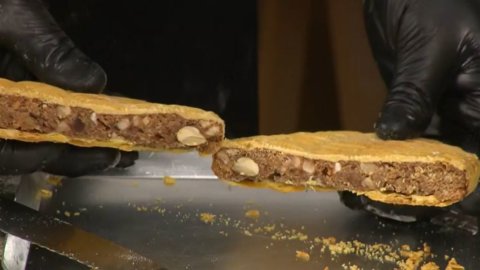Homeland of the Turtei, the tortelli Cremaschi from the particular spizzicatura of the dough and from the sweet filling composed of parmesan, amaretti, sultanas, candied citron, spices and a typical spicy biscuit the mostacciano, the city of Crema in the lower Po Valley defends itself well from nearby Cremona gastronomic city of excellence with a series of typical products that allow it to present itself with honor in the presence of the important neighbor, boasting its own original gastronomic identity. Alongside the turtei we find, in fact, the Salva a table DOP cow's cheese, with raw texture, with washed rind its origin dates back to the XNUMXth century traditionally eaten with Tighe, a pickled green Lombard pepper which goes well with cotechino and boiled meats and then again the Pipetto halfway between meatloaf and savoy cabbage flan, butter, garlic, parmesan and nutmeg consumed in winter. But even on sweets Crema has a lot to say. Original sweets like the Gold braid, made with abundant butter and enriched with raisins and candied citron and orange whose softness is guaranteed by natural leavening, considered a good luck gift for the holidays. And it still needs to be mentioned Bertolina cake based on strawberry grapes that can only be found in autumn at harvest time, whose origins date back to the 800s but it remains to be verified because there is no official recipe for this cake, some make it with the dough for cakes, others with bread dough, and in bakeries and pastry shops they also sell it in slices. And then, topical news, there are the Chisolis, balls filled with a dough prepared with lemon zest brewer's yeast sultanas apple and lard which during the carnival period they are prepared in all homes.
For some it dates back to the Romans, for others to the Jews expelled from Spain in 1492, more likely it was a nutritious fast food for pilgrims on the Via Francigena
But the Cremasco dessert par excellence is the Spongarda which has the appearance of a sort of tart completely closed on all sides, even in the upper part very ancient origins who had the honor of the limelight of the cinema screens appearing in one of the episodes of the cult saga of the 50s and 60s of “Don Camillo and Peppone” epic antagonists in the municipality of Brescello in the lower Po valley iexpired at book by Giovannino Guareschi printed in 20 million copies and sold all over the world.
A dessert that hides a delicious spiced filling based on dried fruit, almonds, hazelnuts, pine nuts, walnuts, candied fruit and sultanas which are mixed with honey, apricot jam, grain nougat in some versions also made with mostaccino, spiced biscuit which is used for the filling of tortelli. Its origins are lost in the mists of time. For some it even dates back to the Romans (who loved combining spices with dried fruit with superstitious value), among other things, its name derives from the Latin spongia (sponge) due to its characteristic of being a soft dessert and spongy. For others he would have Jewish origins, the Jews expelled from Spain in 1492 by Queen Isabella the Catholic would have been imported into Italy inspired by Torquemada, for whom their faith and habits were becoming dangerous for Christians.
A world of delicacies: dried fruit, almonds, hazelnuts, pine nuts, walnuts, candied fruit, raisins, honey, apricot jam, granulated nougat
But perhaps the version closest to its history derives from the hypothesis that the Spongarda was the favorite food of pilgrims on the Via Francigena is from all over Europe they descended on Rome to acquire indulgences and blessings to continue in case to the Holy Land. With its high content of nutritious elements including dried fruit and sugars, this fast food ensured a good energy requirement for those who set out to go and receive the papal blessing. Hence the fact that the Spongarda embraces a vast territory including the regions of Lombardy, Emilia Romagna, Tuscany and Liguria and hence the fact that from time to time its denomination undergoes small changes from Spongarda to spunghèda to Spungata.
The historian Pietro Terni talks about it for a banquet in Crema in 1526
Even if many claim its origin, however, it must be said that La Spongarda has essentially linked its name to the city of Crema. If in a document dated 6 January 1473 it appears that a spongata de berselo was given as a gift to Duke Ercole of Ferrara, certainly the the first certified testimony in Crema is by the historian Pietro Terni who mentions among the courses of a banquet of 1526, a soft and spongy cake, from the Latin spongia. More recently it has entered the list of traditional agri-food products of the Emilia Romagna region.
Its processing is long and laborious, so much so that the Crema pastry chefs joined the Spongarda Congregation in 2009 for the purpose of protecting and promoting its diffusion outside Crema.
The recipe of the Emilian Spongarda
Ingredients
For the stuffing
100 gr of dry biscuits (actually in ancient times dry bread was used)
50 g of toasted walnuts
50 g of toasted hazelnuts
50 g of toasted almonds
a spoonful of granulated sugar
200 gr of honey
100 ml of dry white wine
nutmeg to taste
ground cinnamon to taste
pepper powder to taste
50 g of raisins
30 gr of candied citron
20 gr of candied orange
30 pinenuts
Shortbread ingredients
300 00 grams of flour
150 g sugar
a pinch of salt
100 g butter
a spoonful of olive oil
100 ml of sparkling white wine
Method
Crush dry biscuits until crumbly
Chop the dried fruit with the granulated sugar
Simmer the honey and white wine in a saucepan over low heat for two to three minutes.
Add the grated nutmeg, the dry biscuits and, stirring constantly, continue with a pinch of cinnamon, pepper, the chopped dried fruit, the raisins, the candied citron, the candied orange and the pine nuts.
When you have obtained a homogeneous mixture let it rest for a day covered with a transparent film.
It's time to proceed with the shortcrust pastry. Put the flour, granulated sugar, salt and butter at room temperature in a bowl.
Knead the dough briefly by hand or with a mixer. Add the olive oil and the white wine and continue to work until a homogeneous mixture is obtained.
Roll out half of the dough and place it on a buttered mould. Then pour the filling and cover everything with the other half of the dough. Place in a preheated oven at 180 degrees for half an hour. When cooked, spread icing sugar on the Spongata and let it rest





